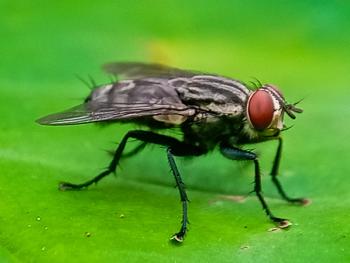
Just Ask the Expert: What fecal analysis method do you use?
Dr. Joyce Knoll provides her advice for this reader query.
Dr. Knoll welcomes clinical pathology questions from veterinarians and veterinary technicians.
What do you recommend for routine fecal assessment for parasite ova?
Wayne L. Hunthausen, DVM
Animal Behavior Consultations
Westwood, Kan.
Centrifugal fecal flotation using Sheather's sugar solution is considered the gold standard method for detecting most, if not all, veterinary helminth eggs and coccidial oocysts1,2 and is the most suitable test for routine screening. Fecal flotation works on the principle that most parasite eggs (and some larvae) have a specific gravity of about 1.05 to 1.203 so they are less dense than flotation solutions. As a result, parasite eggs (and some larvae) will rise to the surface of the flotation solution. Centrifugation decreases the length of time required for eggs to float to the surface, consistently recovering more eggs than standing flotation methods.1,2 In addition, parasites such as Trichuris species with low numbers of dense eggs are more likely to be detected after centrifugation (see
Joyce S. Knoll, VMD, PhD, DACVP
Sheather's sugar solution, which can be homemade (see
Regardless of your choice of flotation solution, it is important to verify its specific gravity with a hydrometer and then check it on a routine basis (e.g. monthly) to detect any changes caused by evaporation. An excessively high specific gravity can distort eggs or even rupture eggs or protozoal cysts (e.g. Giardia species). In fact, because of the differences in specific gravity, zinc sulfate rather than Sheather's sugar solution is recommended for isolating Giardia species cysts.
If possible, analyze a minimum of 1 to 2 g of feces. Smaller amounts may result in false negative results, particularly if eggs are present in low numbers in the feces. The feces should be relatively fresh and, ideally, analyzed on the day of collection, since eggs will continue to develop or hatch after the stool has been passed. While refrigeration may slow some of these changes, the more fragile organisms (e.g. Giardia species) may not survive storage.
Other techniques may be warranted in some situations. A fecal wet mount is useful for identifying motile organisms such as Giardia species trophozoites. Fecal cytology (air-dried smear) can be used to identify cellular infiltrates and assess bacterial flora (e.g. Campylobacter or Clostridium species). The Baermann technique is used to recover nematode larvae, such as Aelurostrongylus and Strongyloides species, while a fecal sedimentation technique can help isolate fluke eggs and embryonated nematode eggs that are denser and less likely to float. The choice of technique used for fecal assessment should depend on clinical signs and likely differential diagnoses, and, in some patients, a panel of fecal tests may be warranted.
Joyce S. Knoll, VMD, PhD, DACVP
Department of Biomedical Sciences
Cummings School of VeterinaryMedicine
Tufts University
North Grafton, MA 01536
REFERENCES
1. Broussard JD. Optimal fecal assessment. Clin Tech Small Anim Pract 2003;18(4):218-230.
2. Dryden MW, Payne PA, Ridley R, et al. Comparison of common fecal flotation techniques for the recovery of parasite eggs and oocysts. Vet Ther 2005;6(1):15-28.
3. David ED, Lindquist WD. Determination of the specific gravity of certain helminth eggs using sucrose density gradient centrifugation. J Parasitol 1982;68(5):915-919.
Newsletter
From exam room tips to practice management insights, get trusted veterinary news delivered straight to your inbox—subscribe to dvm360.




